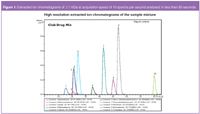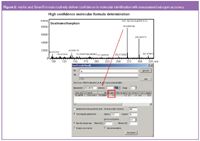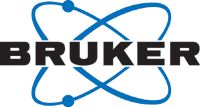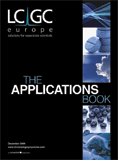Analysis of Complex Pharmaceutical Mixtures by maXis with Fast Chromatography
In the pharmaceutical industry the increased efficiency brought about by new fast chromatography methods needs to be matched by commensurate mass spec capabilities. maXis UHR-TOF is the instrument of choice to keep up with fastest chromatography.
Ray Sanchez, Penggao Duan and Darwin Asa, Bruker Daltonics, Billerica, Massachusetts, USA.
Introduction
In the pharmaceutical industry the increased efficiency brought about by new fast chromatography methods needs to be matched by commensurate mass spec capabilities. maXis UHR-TOF is the instrument of choice to keep up with fastest chromatography.

Figure 1
Many high performance accurate mass and orbital trapping MS systems are unable to provide sufficient high resolution data at fast chromatography speeds. Fast separation technology can significantly reduce the time required to analyse a given sample. Chromatography methods can be reduced sometimes by an order of magnitude. These short run times produce chromatograms with peak widths of less than a few seconds wide. The new maXis system is the only high performance MS system capable of operating with those fast run times without sacrificing resolution or sensitivity. Here we demonstrate the typical results that can be achieved by the combination of fast chromatography with the maXis to analyse a complex pharmaceutical sample.

Figure 2
Experimental
UHPLC system:
- Waters Acquity UPLC with DAD detector (210–400 nm)
- Acquity BEH C18 1.7 µm 2.1 x 50 mm
- Column temperature: 40 °C
Mobile phase:
- 0.1% formic acid in water
- 0.1% formic acid in ACN
Gradient:
- 20%–40% B in 60 sec
- 40%–100% B in 5 sec
- 100% B for 172 sec *followed by column equilibration
Flow rate: 0.6 mL/min
Injection volume: 2 µL
Results
In this study, the maXis was challenged to identify a series of unknown drug compounds that had been separated by UHPLC. Using a typical reverse phase C18 gradient separation method, 7 of the 10 compounds were base line separated by the UHPLC in 85 seconds at 10 Hz sampling rate. The maXis was then able to discern the presence of 10 compounds in the sample, despite the lack of chromatographic separation of three of the compounds, even at levels as low as 10 pg on column. Furthermore, the excellent mass accuracy (<1 ppm) and resolution (avg ~50 K) of the results generated by the maXis, when used in conjunction with the SmartFormula 3D software, were able to use the data to correctly identify all 10 compounds and unequivically determine their molecular formula. This is exceptional performance from a Q-TOF, especially with a UHPLC speed separation.
MS system: Bruker Daltonics maXis
Spectral acquisition 10 full spectra per second
Dry heater 180 °C
Nebulizer 2 Bar
Capillary 4500 V
Dry gas 6 L/min
ESI positive polarity
Range 100–800 m/z
Calibrant Lithium formate (16 mM)
LockMass calibration methylstearate
Technology
- UHR-TOF
- Dual ion funnel
- Ion cooler technology
- Dual stage reflector
Conclusion
Bruker Daltonics has developed a new state of the art mass spectrometer, the maXis, capable of keeping pace with the current demands of high-throughput analysis without sacrificing accuracy, sensitivity or resolution. In this study the maXis was capable of delivering:
- Mass accuracy of 1 ppm or less for typical pharmaceutical compounds
- Extracted ion chromatograms with ±1 mDa window
- 20 spectra per second
- 40 000 to 60 000 resolution
Keywords
- UHPLC
- Drug compounds
- Formula determination
- Molecular formula determination
Instrumentation and Software
- maXis
- SmartFormula
For research use only. Not for use in diagnostic procedures.

Bruker Daltonik GmbH
Fahrenheitstr. 4, 28359 Bremen, Germany
tel. +49 421 2205 0 fax +49 421 2205 104
E-mail: sales@bdal.de
Website: www.bdal.com

Automated Sample Preparation (ISO 20122) for MOSH/MOAH in Seasoning Oils
May 6th 2025This work presents an Automated Sample Preparation procedure for MOSH/MOAH analysis of Seasoning Oils. We compare results from a manual epoxidation procedure compliant with DIN 16995 with results based on fully automated sample preparation (epoxidation and saponification) compliant with ISO 20122. In both cases, online clean-up via activated aluminum oxide (AlOx) are used to remove interfering n-alkanes from the MOSH fraction during the HPLC run. Automated data evaluation using a dedicated software (GERSTEL ChroMOH) is presented.
Free Poster: NDSRI Risk Assessment and Trace-Level Analysis of N-Nitrosamines
April 25th 2025With increasing concern over genotoxic nitrosamine contaminants, regulatory bodies like the FDA and EMA have introduced strict guidelines following several high-profile drug recalls. This poster showcases a case study where LGC and Waters developed a UPLC/MS/MS method for quantifying trace levels of N-nitroso-sertraline in sertraline using Waters mass spectrometry and LGC reference standards.

.png&w=3840&q=75)

.png&w=3840&q=75)



.png&w=3840&q=75)



.png&w=3840&q=75)













